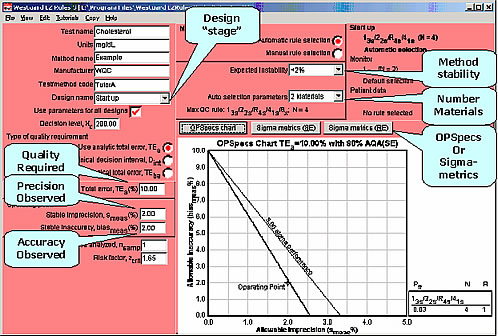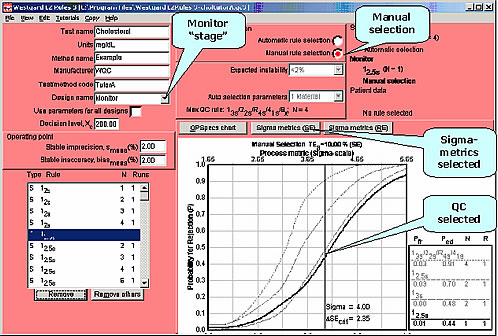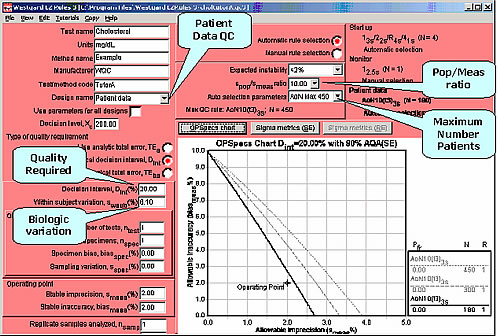Essays
Solutions for a Taxing Problem
May 2005
QC is like taxes. Ask anyone about it, and it's unlikely that you'll hear a happy response. But like taxes, QC is something you can't avoid if you want a functional and productive society or healthcare community. Westgard QC provides a sneak peak at a program designed to help make the "QC tax" less burdensome on you.
May 2005
I’m always happy to arrive at April 16 and see a fresh new year ahead. For me, the new year starts only after the taxes for the old year are finished. While I don’t object to paying my fair share of taxes, I still find the process painful, even though it is made much easier by today’s user-friendly computer "taxware" programs. And those tax programs have given us some good ideas for implementing a more user-friendly QC Design program.
Those of you who have used the EZ Rules program know that it functions like the interview mode of a tax program. It asks questions and requests certain information from the user. Once all the necessary information has been collected, the program determines the right QC rules and number of control measurements.
Some users, however, still prefer the older QC Validator 2.0 program, which operates with a single parameter entry screen. In a sense, this corresponds to the “forms” mode of a tax program. It is much more efficient for users who spend a lot of time doing this kind of work, just like a tax specialist who would prefer to work directly with the tax forms rather than going through the interview mode of operation.
To meet the needs of both kinds of users, we will soon introduce EZ Rules 3, a new program that offers both the interview and form modes of operation. This EZ Rules will first be provided to participants in our June Six Sigma workshop and then will be announced at the July AACC meeting in Orlando.
What’s new with EZ Rules 3?
- Provides both interview and form modes of operation. EZ Rules 3 starts out in the interview mode to support the user during the learning phase when on-screen directions and guidance are valuable. Once the user is comfortable with the QC design process, the form mode can be set (through preferences) as the default mode of operation.
- Supports multistage QC designs. The “3” refers to 3-stage design capability, which allows a user to select a “Startup” design for the initial qualification of a method, then a “Monitor” design for following routine operation, and finally a “Patient Data” design that makes use of Average of Normals algorithms to monitor the longer run method stability.
- Enables user customization of selection criteria and logic. The behavior of the automatic QC selection process depends on certain default settings for selection criteria and logic, which are now open for modification by the user. With the default settings, the program follows our best advice and judgment, but there may be situations and applications where a different optimization is appropriate. Users now have more flexibility to adapt the program to their own preferences of operation.
The interview mode of operation is almost identical to the earlier version of EZ Rules, so we won’t describe it here. For a view of those screens, go to EZ Rules for Easier Operation. The new form includes all the required input parameters, plus a graphical display that can be set to show the OPSpecs chart or Sigma-metrics graph. We’ll show the form model of operation in the examples that follow.
STARTUP Design
As shown below, the program starts out in the Startup stage of design, which we recommend for determining the optimal QC using the automatic QC selection methodology. The screen here shows a cholesterol example, where the medical decision level is 200 mg/dL, the allowable Total Error is 10%, the observed method CV is 2.0%, the observed method bias is 2.0%, a low frequency of problems (<2% of runs) is expected because this is a highly automated method, and 2 different levels of control material are to be analyzed. The OPSpecs chart shows the selected QC design, which is a multirule procedure with 4 control measurements per run. The “buttons” above the chart allow the user to view the Sigma-metrics graphs as well.
MONITOR Design
Analysts may be unhappy that this cholesterol method will need 4 control measurements to assess whether it is working properly in the next analytical run. Here’s where the multistage strategy becomes useful. This method can be checked initially using 4 controls, then monitored during operation with a lower number of controls. The Monitor design can be selected manually as shown in the screen below, where a single-rule with 2.5s control limits and 1 control measurement will provide a probability of almost 0.50 (or 50% detection) of the medically important systematic error. Use of the Sigma-metrics graph is preferred here to see more exactly the error detection available from the possible QC procedures.
PATIENT DATA Design
For completeness, the Patient Data stage is also illustrated here. While the number of laboratories that employ such designs today may be small, patient data procedures are expected to play a bigger role in the future. In the design here, a clinical quality requirement is employed making use of the NCEP guidelines for test interpretation, which specify a different physician action for a cholesterol of 200 mg/dL vs a cholesterol of 240 mg/dL. The difference between these two decision levels defines a gray zone of 40 mg/dL or 20% at a level of 200 mg/dL. Note also that it is necessary to include the within-subject biologic variation (6.1%), the ratio of the population to measurement SDs (10 for cholesterol), and the maximum number of patient specimens that will be available for use with the average of normals algorithm (450 here for high volume laboratory). In this case, it is necessary to accumulate 180 patient specimens for the AoN algorithm to effectively monitor the stability of the process.
QC, Death and Taxes
In some ways, mentioning "QC" in the same breath as "taxes" is unfortunate. Both are already loathed by many people, and linking the two probably makes things worse. There are always complaints that taxes are too high, that QC is too much effort, and that both should be reduced, flattened, or ideally eliminated (or possibly "equivalented"?). However, just like death and taxes, QC is really unavoidable. Without taxes, there is no government, no military, no medicare, no medicaid, no social security, etc. Without QC, there is no assurance that you have anything more than a random number generator. As we've said before, you can pay now or you can pay later (and pay more). Taxes protect the citizens of our country. QC protects the welfare of our patients.
EZ Rules 3 shares one more aspect with taxware programs: the return. In the end of all the questions and data entry, there is a simple result, a control rule and number of measurements. This is like the refund or a payment at the end of the tax return. If you have a good method, you may find that the control rule recommendation is less than the current control rule you are using (wider limits, fewer controls, simpler rules). Or, if the method performs poorly, you may find that the control rule recommendation is harder than your current control rule (tighter limits, more controls, more rules). Even with those difficult situations where you need to "pay" more QC for the method, the Multistage QC techniques allow you to break that payment up into more palatable stages.
James O. Westgard, PhD, is a professor of pathology and laboratory medicine at the University of Wisconsin Medical School, Madison. He also is president of Westgard QC, Inc., (Madison, Wis.) which provides tools, technology, and training for laboratory quality management.



